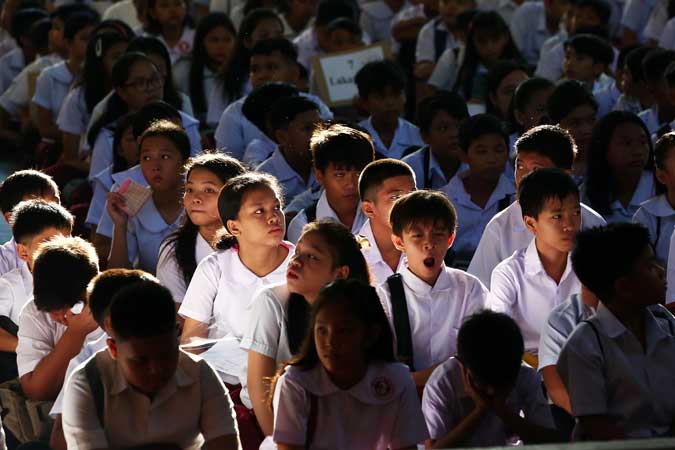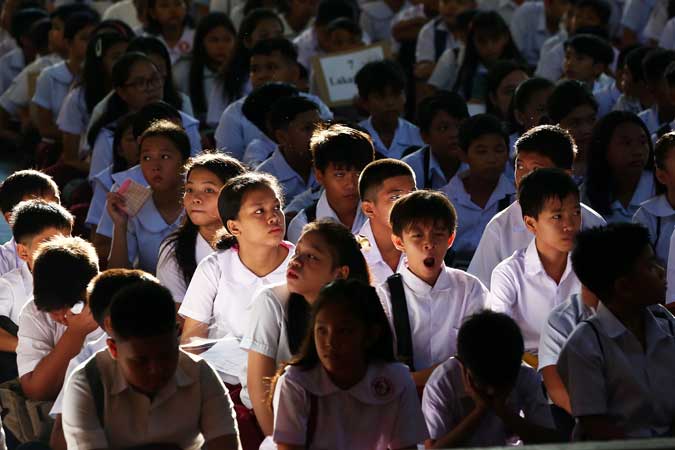
By Arjay L. Balinbin, Senior Reporter
FIFTH GRADE STUDENTS in the Philippines are falling behind their counterparts in some Southeast Asian countries in reading, writing and mathematics, with a significant percentage of students still performing at levels expected in early years of primary education, a regional study showed.
Data from the Southeast Asia Primary Learning Metrics (SEA-PLM) 2019 released on Tuesday showed the percentage of Grade 5 Filipino students who achieved minimum proficiency in reading, writing and mathematics was significantly lower than Vietnam and Malaysia. Fifth-graders in the Philippines were at par or sometimes even worse than those in Cambodia, but performed slightly better than those in Laos and Myanmar.
The study was conducted by the Southeast Asian Ministers of Education Organization and the United Nations Children’s Fund (UNICEF), with technical support from the Australian Council for Educational Research. It assessed the performance of Grade 5 learners from selected schools in six countries — Cambodia, Laos, Myanmar, the Philippines, Vietnam, and Malaysia — in three learning domains: reading, writing, and mathematics.
The study anchored its assessment on the United Nations Sustainable Development Goal (SDG) No. 4, which is “to ensure that all girls and boys complete free, equitable and quality primary and secondary education leading to relevant and effective learning outcomes” by 2030.
Majority of Grade 5 students in the Philippines had a reading proficiency level equivalent to that in the first years of primary school, with 27% of the students still at the level (the lowest in band scale of 2 and below to 6 and above) where they can only “match single words to an image of a familiar object or concept.”
Only 29% of grade 5 learners in the country are at the level where they are able to “read a range of everyday texts, such as simple narratives and personal opinions, and begin to engage with their meanings.”
If ranked according to the percentage of Grade 5 students performing at or above the SDG indicator by country (band 6 and above), the Philippines is the second-worst performer with 10%, following Laos with only 2%.
Vietnam had the highest percentage with 82%, followed by Malaysia (58%), then Cambodia and Myanmar, with 11% of Grade 5 students having met the minimum reading standard.
In the band 6 and above level, students are able to “understand texts with familiar structures and manage competing information.”
WRITING, MATH
In terms of writing, only 1% of Grade 5 learners in the Philippines achieved “higher levels” of proficiency, or those who met the highest level in the standards used by the study. These learners are those with the ability to “write cohesive texts with detailed ideas and a good range of appropriate vocabulary.”
Almost half or 45% of Grade 5 learners in the Philippines were in the lowest band, which means they have “limited ability to present ideas in writing.”
“In Cambodia, Lao PDR, Myanmar and the Philippines, a very limited number of Grade 5 students achieved higher levels of proficiency in writing… More than 60% of students were in the 3 lowest bands. The highest performers of this group can produce very limited writing, with simple, insufficient ideas and limited vocabulary. The weakest students have only limited ability to present ideas in writing,” the study said.
For mathematical literacy, only 5% and 1% of Philippine Grade 5 students met the highest levels (band 8 and band 9 and above, respectively) in this area of learning.
Band 8 identifies learners as having the ability to “think multiplicatively and convert between units” while students in band 9 and above “can reason about triangles to find an unknown side length using information about the perimeter, and they can solve problems using frequency distributions.”
The study said 18% and 23% of Grade 5 learners in the Philippines are in the lowest bands (band 2 and below and band 3, respectively).
“In Cambodia, Lao PDR, Myanmar and the Philippines, modest percentages of Grade 5 students have achieved the mathematical literacy skills expected at the end of primary school, as indicated by a SEA-PLM 2019 mathematical proficiency of Band 6 and above. This implies that in these countries the majority of Grade 5 students are still working towards mastering fundamental mathematical skills,” the study said.
The main survey data were collected towards the end of the 2018-2019 academic year from a “nationally representative sample of the whole population of students enrolled at Grade 5. Testing was done in November 2019, while data collection was conducted in February 2019.
“Schools were selected following a systematic procedure with selection probability proportional to the number of enrolled Grade 5 students from the targeted population. A minimum of 150 schools were sampled from each participating country. One Grade 5 class was selected at random within each sampled school. All students of the selected class were sampled,” the report explained.
The tests were in the official languages of instruction in Grade 5 in each country.
In the Philippines, mother-tongue language is used as a medium of instruction from grades 1 to 3, while Filipino and English are used for Grades 4 and 5.
While countries are facing challenges due to the pandemic, the SEA-PLM study noted this has also given “opportunities to experiment with hybrid and flexible learning, and organizational pathways in education delivery and services.”
Among its policy recommendations include prioritizing early learning; ensuring on-time enrolment for all students; and implementing progressive learning standards in the curriculum of basic education.
In an e-mailed reply to questions, College of Education Dean Jerome T. Buenviaje of the University of the Philippines-Diliman said the assessment describes the “challenging situation of our primary education and our education system in general.”
“Early education is a crucial stage in the development of learners, thus, teachers at this level must be skillful in imparting basic functional literacies,” he said.
Mr. Buenviaje recommended that “we should place the ‘best and the brightest’ teachers at the early education stage of the Filipino learners.” Teachers should also undergo research and capacity development, he added.
“Teachers in the early grades must undergo a standard training to address this issue. When I say standard training, this should be a sort of a short course that focuses on pedagogical approaches and strategies where specific skills will be assessed for certification and a recertification after a few years.”


